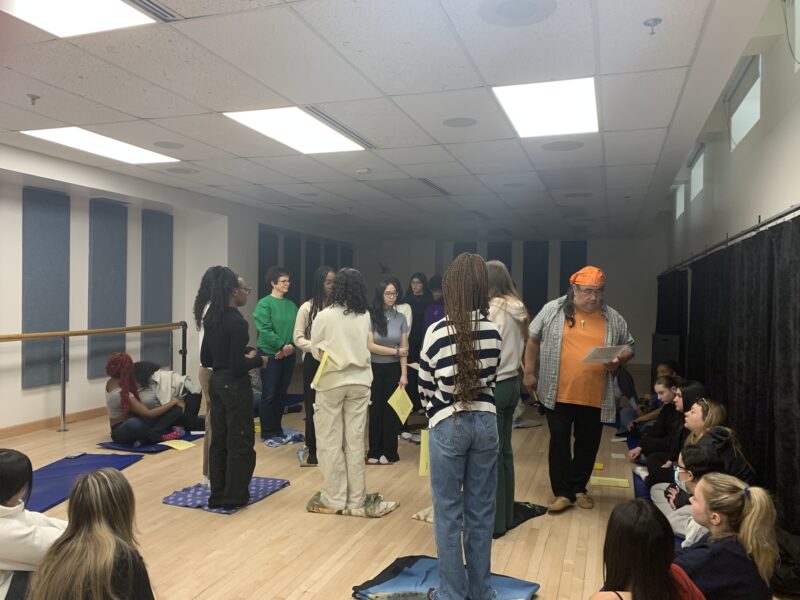As a Sociology teacher, Laura Shea has experienced the KAIROS Blanket Exercise six times with different classes of students and Indigenous facilitators at Dawson. “I always learn from the facilitator and students,” she said. “It is very powerful experiential learning and I gain something different each time.”
Laura is often facing a roomful of students who don’t know much about the history of Indigenous-settler relations from an Indigenous perspective. “With the KAIROS Blanket Exercise, students are given the role of being Indigenous people and they learn about 500 years of Indigenous-settler relations in about two hours,” she said in an interview with Dawson’s Communications Office.
The KAIROS Blanket Exercise was developed in response to the Calls to Action of the Truth & Reconciliation Commission (TRC) in 2015. Through this activity, students are directly participating in the Calls to Action.
First time for many
For Laura’s students, the blanket exercise is often the first time that they meet an Indigenous person. The Indigenous facilitator is “very present in mind, body and spirit,” Laura said. “This is very different from the role of a teacher in the western tradition.”
Laura recently offered the experience to her students in February through funding from the Student Academic Enrichment Fund of the Dawson Foundation. The facilitator was Timothy Armstrong, who lives in Kahnawà:ke and comes from the Brokenhead Ojibway Nation in Manitoba.
Timothy says he facilitates “Blanket Exercises because I believe it’s important to offer a balanced telling of Canadian history from an Indigenous viewpoint and, as hard as it is at times sharing my own story, I want the participants to realize that, despite what my people have been through, we are a proud and strong people who need to have their true story told.”
Blankets represent Turtle Island
During the exercise, the blankets are laid on the floor and represent Turtle Island, Laura said. “The blankets become smaller and smaller and there is very little blanket left. However, it is not just a damage narrative. It also speaks to resistance and resurgence. There has been resistance all the way through history. When Indigenous sovereignty and self-determination are honoured, we add to the blanket.”
Listening to the students, Laura has found that the experiences of Indigenous peoples are very relatable for many of her students, many of whom come from places like the Caribbean or Morocco and have their own experiences of colonization.
Student Camélia Bakouri shared that the exercise, which she did in February 2023, “made me understand the complexity of Indigenous history in Canada. By participating in the narration but also visually observing the land becoming smaller as well as the community, I recognize the current challenge….
Student reflections
“The animator also brought his own stories, and they touched me a lot. Hearing how the scrolls and the facts given during the activity concretely affect him and his family put things in perspective. Furthermore, afterwards, I draw a personal similarity with the history of my family. Colonialism is not a resolved issue like high school and general education make it seem. Multiple minorities around the world suffer from a racist system that is prone to assimilation and exploitation of resources without respect for locals and/or Indigenous groups.”
Student Sarah Orejuela, who was in the same exercise, shared that “the history of Indigenous peoples and white settler colonials was much more visual and palpable with the help of the blankets and the speeches written by real people. Moving around the blankets and seeing large groups of people leave from them made me wonder about how Indigenous communities lost their members in a similar manner. This metaphoric experience that physically integrated me into some of the real effects of colonization and dispossession helped me to put myself in other communities’ shoes and feel the constant harms that First Nations, Métis, and Inuit had to survive.”
Sarah appreciated that the facilitator “depicted to what extent Indigenous people have resurged, resisted and reclaimed what belongs to them despite the constant efforts of settler colonials to eliminate them permanently. I realized the unimaginable power that Indigenous peoples carry within them, and I learned that, rather than just feeling sorrow, I must respect the land that I live in, and the people that made it possible for us to settle here at their own expense. Now I question myself for moving from Colombia but having to make my immigration process and the Oath of Citizenship to the Canadian government and the Crown; after all it is not their place, land or resources for them to be giving it away to others.”
Help other students experience the Blanket Exercise
Those who would like to help other students experience the KAIROS Blanket Exercise, may make a donation here: https://dawsoncollege.givecloud.co/product/SAEF-KAIROS-Blanket-Exercise/kairos-blanket-exercise



